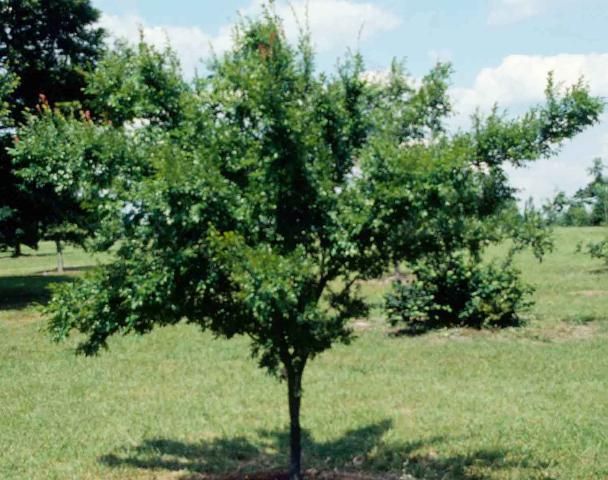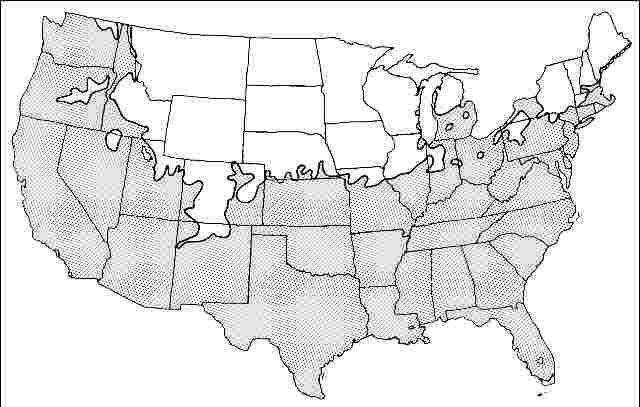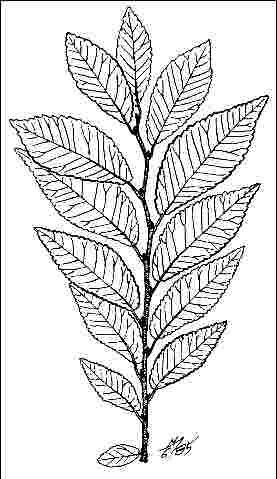Introduction
'Dynasty' Chinese elm originated from the National Arboretum's selection program and grows perhaps 50 feet high and wide (about two feet per year), making it an ideal shade, specimen, street or parking lot tree. An excellent tree that is surprisingly under-used, 'Dynasty' Chinese elm possesses many traits which make it ideal for a multitude of landscape uses. A fast-growing, deciduous or evergreen tree, 'Dynasty' Chinese elm forms a graceful, vase-shaped, spreading canopy of long, arching, and somewhat weeping branches which are clothed with two to three-inch-long, shiny, dark green, leathery leaves which become transformed into various shades of red in the autumn. Branches grow up and away from the ground making it ideal for a street tree since branches do not droop toward the ground as much as other cultivars. The tree is evergreen in the southern extent of its range. The somewhat exfoliating, dark grey bark reveals random, mottled patterns of darker grey, green and occasionally, orange, and brown, adding great textural and visual interest, especially to its winter silhouette. But the bark probably is not as showy as some of the other selections.

Credit: Ed Gilman, UF/IFAS
General Information
Scientific name: Ulmus parvifolia
Pronunciation: UL-mus par-vih-FOLE-ee-uh
Common name(s): 'Dynasty' Chinese elm, 'Dynasty' lacebark elm
Family: Ulmaceae
USDA hardiness zones: 5B through 10A (Fig. 2)
Origin: not native to North America
Invasive potential: little invasive potential
Uses: sidewalk cutout (tree pit); reclamation; urban tolerant; street without sidewalk; shade; specimen; parking lot island < 100 sq ft; parking lot island 100-200 sq ft; parking lot island > 200 sq ft; tree lawn 3-4 feet wide; tree lawn 4-6 feet wide; tree lawn > 6 ft wide; highway median
Availability: somewhat available, may have to go out of the region to find the tree

Description
Height: 40 to 50 feet
Spread: 35 to 50 feet
Crown uniformity: symmetrical
Crown shape: vase, round
Crown density: moderate
Growth rate: moderate
Texture: fine
Foliage
Leaf arrangement: alternate (Fig. 3)
Leaf type: simple
Leaf margin: serrate
Leaf shape: elliptic (oval), ovate
Leaf venation: pinnate
Leaf type and persistence: deciduous
Leaf blade length: less than 2 inches
Leaf color: green
Fall color: red, yellow
Fall characteristic: showy

Flower
Flower color: green
Flower characteristics: not showy
Fruit
Fruit shape: oval
Fruit length: less than .5 inch
Fruit covering: dry or hard
Fruit color: brown
Fruit characteristics: does not attract wildlife; not showy; fruit/leaves not a litter problem
Trunk and Branches
Trunk/bark/branches: branches droop; showy; typically multi-trunked; thorns
Pruning requirement: needed for strong structure
Breakage: resistant
Current year twig color: gray, brown
Current year twig thickness: thin
Wood specific gravity: unknown
Culture
Light requirement: full sun, partial sun, or partial shade
Soil tolerances: sand; loam; clay; acidic; alkaline; well-drained; occasionally wet
Drought tolerance: high
Aerosol salt tolerance: moderate
Other
Roots: not a problem
Winter interest: yes
Outstanding tree: yes
Ozone sensitivity: unknown
Verticillium wilt susceptibility: susceptible
Pest resistance: resistant to pests/diseases
Use and Management
Select trees with branches spaced along one trunk. It is not essential that this trunk be straight. Trees which have a trunk less than about two inches in diameter often require staking and some early pruning to prevent leaning and blowover due to a heavy crown and unstable root system. Nursery operators often train trees to a single, straight trunk by staking at an early age. Leave branches on the lower trunk during this training period to encourage caliper development on the lower trunk.
Older trees look nice with an occasional light thinning to show off the wonderful trunk and branch structure. The tree is often topped in the nursery to create a full head of foliage and branches originate from one point on the trunk. There is not enough room on the trunk to support this type of branch structure, and some may split out from the tree as it ages. This tree may take more effort to properly train and prune when it is young than some other species.
Please do not confuse it with Ulmus pumila, the Siberian elm. Siberian elm is far inferior to Chinese elm and should not be planted, except perhaps in extreme climates where the limits of most other trees are tested.
The root system is comprised of several very large-diameter roots which can grow to great distances from the trunk. These are usually located fairly close to the surface of the soil and can lift sidewalks. They can get into sewer lines causing severe damage. But these roots are usually not a problem and should not be cause to eliminate this tree from your urban tree planting program. To the contrary, Chinese elm is among the top urban trees on most recommended tree lists in the South and Midwest. Occasionally, root suckers emerge from beneath the canopy and will require pruning.
'Dynasty' Chinese elm will grow in full sun on a wide range of soils, adapting easily to extremes in pH or moisture, and tolerates wet soil, urban heat, and wind. Trees will look their best, though, when grown in moist, well-drained, fertile soil. Recently-transplanted trees often lose foliage during the summer or in severe drought. Newly planted trees do not tolerate standing water.
Many cultivars are available for size and form: 'Catlin' is dwarf; 'Drake', USDA hardiness zones 7 to 9, has small, dark green leaves, sweeping, upright branches forming a rounded crown, and greater leaf retention being almost evergreen in California and Florida; 'Dynasty' has smooth, dark grey bark, smaller leaves and is vase-shaped, with red fall color in the north; 'Frosty' has a small (0.75-inch-long), white-margined leaf which may revert back to green; 'Emer I' has a dark green, fine-textured uniform crown comprised of ascending branches with bright orange, grey and brown exfoliating bark. It is a brand new introduction and the parent tree is reportedly 50 years, 32 feet tall and 54 feet wide; 'Golden Rey' is reportedly hardy to USDA hardiness zone 6, is a moderate grower and may be denser and more compact than the species. This cultivar was selected for its yellow new foliage color which deepens to golden yellow in autumn; 'Pathfinder' has been extensively tested in Ohio for 30 years (USDA hardiness zone 5a). It has a single trunk with broad, upright branches and grows at a moderate height. Bark is nicely exfoliating, fall color is a rich red and this National Arboretum/Ohio Research Site introduction tolerates wet and dry soil. A good tree for tough sites; 'Sempervirens (Pendens)' is more round-headed, weeping and spreading with persistent foliage, almost evergreen in USDA hardiness zones 8b through 10; and 'True Green' has glossy, deep green leaves, a graceful, round-headed outline, and tends to be evergreen.
Propagation is easily done by cuttings.
Pests
It is very resistant of the typical problems which afflict most elms. Borers and chewing insects are a problem. Shows considerable resistance to elm leaf and Japanese beetle.
Diseases
It is usually resistant to Dutch elm disease and phloem necrosis. Cankers may develop on young trunks where soil is excessively wet. These occur on nursery and landscape trees. The causal agent has not been identified but theories abound. Twig blight can be an occasional problem.